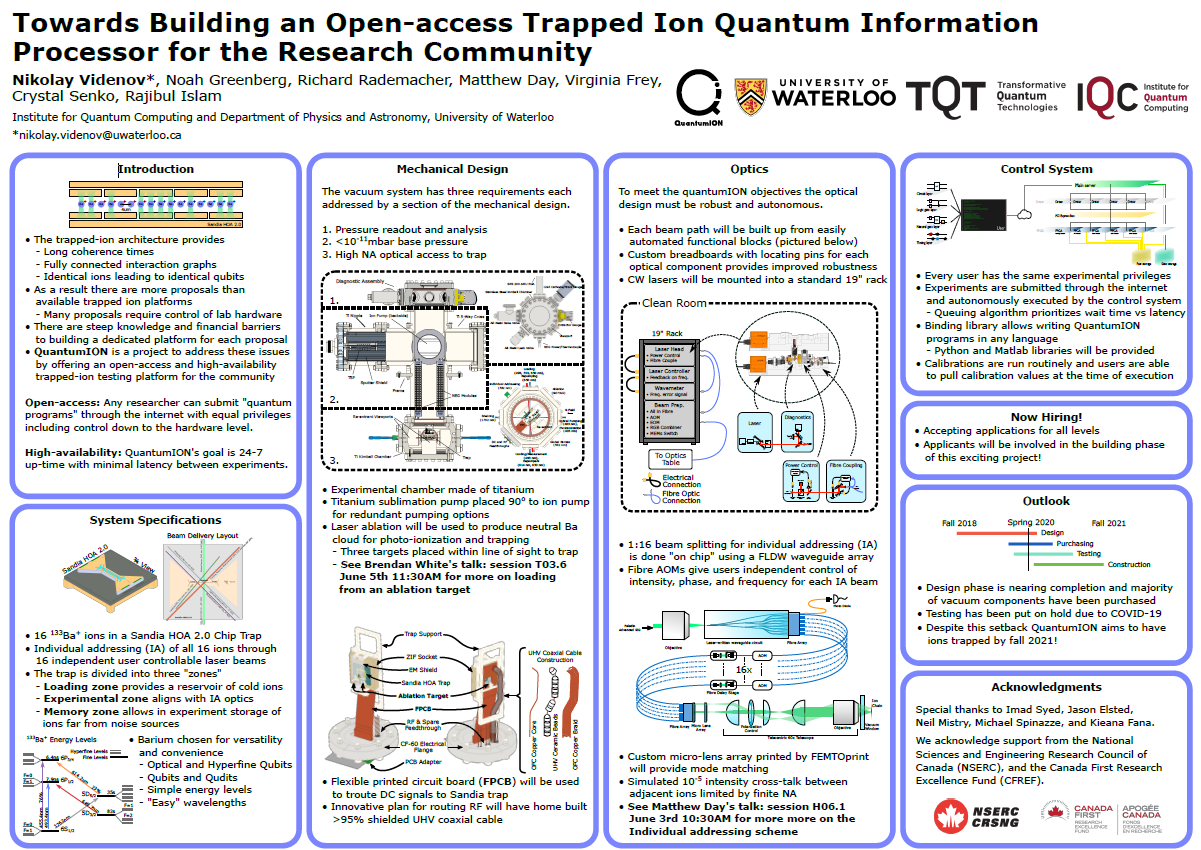Last semester, Nikolay Videnov won the Best Presenter award at the University of Waterloo and the University of Strathclyde’s Virtual Research Colloquium. We love to see UW students succeed at presentations, so we thought we’d reach out and have a short conversation about how that presentation came together, and to pick Nikolay’s brain about the process.

Elise Vist: Can you tell us a little bit about the presentation you gave?
Nikolay Videnov: I gave a 12-minute presentation on the great work we've been doing in the QuantumION group at the Institute for Quantum Computing under the joint supervision of Professor Rajibul Islam (my PI) and Professor Crystal Senko. The talk gave a high-level overview of quantum computing with trapped ions, then focused on the research I have been involved in - developing an optical control architecture for 16 independent laser beams each focused onto an individual ion - and finally wrapping up with an outlook for this research.
EV: What’s your experience with presentations?
NV: Professor Rajibul is a strong believer of sending his students to conferences both small and large. In fact he is the one who suggested I submit an abstract for the UW-Strathclyde conference. By being pushed to engage with conferences regularly I would say I've been able to improve my presenting skills significantly over the years.
EV: That’s awesome that you have such a supportive supervisor. What have you learned about presentations or communicating your research from following Professor Rajibul’s advice?
NV: I worked with Professor Rajibul as an undergaduate prior to my current program and in that time he sent me to CUPC (Canadian Undergraduate Physics Conference), a massive conference where I got to watch around 40 talks…of which I understood around 10. The most common issue was writing the talk at the level of your colleges in the same field instead of the general audience. This was formative for me since it's not helpful to have a polished talk that no-one understands. One of the talks which I did understand and has stuck with me was presented by Professor Stephanie Simmons, a keynote at this conference, and the difference I think was that she had the confidence to make her talk simple. Making a simple talk can make you feel like you're not demonstrating enough knowledge, but that's not the point of a talk.
Despite this experience I do get nervous before presentations! I don't think my nerves are misplaced either, finding out you forgot to breathe halfway through a presentation is a very dire situation. I know from experience! However, I've learned to overcome nerves by practicing my talks ahead of time and focusing on breathing between sentences during the talk.
EV: Practice really is the best way to overcome nerves – I still practice my presentations at least 3 times before I give a talk, and I’ve been doing this for over a decade! When you were preparing your presentation did you use any specific tools or resources?
NV: For making the presentation I used Google Slides with a very bare bones theme, I don't think the technology used is too important. Instead, the key to making the presentation was practicing the talk enough that I felt comfortable with what I wanted to convey on each slide. Once I knew what the goal of each slide was, I had the freedom to improvise on the day of, confident I would come in on time and having said everything I want to say.
I agree that the specific tech you use isn’t the biggest story of a presentation – it’s the way you put it together and use it to support your ideas. Does this mean that you didn’t use a script? How did you actually deliver your talk, and do you have any tips about speaking from your slides that way?
I did not have a script. Writing one takes too long and there's a dissonance between the written 'voice' and speaking 'voice' which I think the audience can pick up on. Instead I make the slides, then just start practicing. Each time I practice the talk I'll refine what I want to say on each slide, sometimes altering the slides so they flow better, or include some idea that comes up naturally when speaking. After enough practice I'll be able to look at any slide and know the purpose of that slide and be able to articulate it. I like this method since I get lots of experience with the slides, but it's not so structured as a script is, so I can take questions during or improvise if anything happens. The core tip, as above, practice! It can also help to jot down in bullet point what the core of each slide is. My method amounts to knowing the core of every slide and semi-improvising a couple sentences on each core.
EV: I’m also not a script-reader, but there are some disciplines that rely on them – it is possible to write a script for a natural speaking voice, but it’s definitely a different kind of writing skill. Since you didn’t have a script, then, I’d like to chat a bit about how you built your presentation. The first thing I encourage people to think about when planning a presentation is their key message or purpose, so that’s where I’ll start: What did you want your presentation to achieve?
NV: The goal of the conference was to foster collaborations between UW and Strathclyde. In that spirit I was hoping to present some technologies we're using in QuantumION which may have applications in other labs. This means focusing on techniques which can be modified for use in other labs, but also omitting details which are too specific to our research to find general use.
EV: How did you make sure you got your message across?
NV: I used two techniques to make my message as clear as possible. Firstly, I tried to tell a story with my presentation - this is something that Prof. Rajibul emphasizes all his students should do in their talks. Having a narrative keeps people engaged and ensures a logical progression of ideas. Secondly, I tried to make my talk as simple as possible while still conveying the core message. Since I was talking to a general audience, I wanted everyone to understand what I was discussing. I think it is very easy to make a talk which is not useful by making the material require too much background knowledge from audience.
EV: Can you tell us a bit about the ‘story’ you told (without getting too technical, of course!)?
NV: The talk was about solving an ion trapping problem in a unique way. To convey this message I started by introducing trapped ion quantum computing as an abstract. Then I walked the audience through a typical trapped ion experiment explaining the steps to getting results in more material terms. With this introduction I was able to contextualize my work in a larger sequence of events making up an experiment. I then again zoomed into the specific step I was working on, explaining first the challenge then the solution we came up with. Finally zooming back out I showed experimental results and gave an outlook. The idea was macro-micro-macro where the micro is what I was actually doing, and the macro gave context. Not a traditional narrative, but having this structure in mind helps slides connect logically.
EV: It really sounds like you enjoy the process of communicating your research – it’s so great to see people who are passionate about not just doing the research, but also making it understood by a wider audience! What did you have the most fun with, while preparing or delivering it?
NV: I enjoyed watching everyone else's talks in my session the most. After spending all that time focused on my talk it's great to relax and see what the other presenters have done. This is the main appeal of conferences I think, the ability to engage with other people's ideas!
EV: That’s also my favourite part of conferences – I definitely miss being able to wander into different rooms and chat with people around a coffee machine though…But you can still get a lot out of attending virtual talks. One of the best ways to get better at giving presentations is watching them! You can learn a lot about what to do (or what not to do!) by paying attention to how other people present their work. Did you see something in someone else’s presentation that inspired you, or that you want to use in your own talks?
NV: The first speaker, Ieva Cepaite from the University of Strathclyde had an excellent talk which did a good job explaining theory research to the audience. Personally, I think explaining theory results is harder than experimental results. Partially because I'm an experimentalist, but especially because the concepts are so abstract. Ieva had intuitive explanations capped off with a very slick animation. The animation showed the time evolution of a system naturally by including a time dependent graphic. She did an excellent job, but the animation really inspired me to use more multimedia in my talks.
EV: If any of our readers are also interested in using more multimedia, I recently learned about Flourish, a tool you can use to animate charts, though simple animation is also doable in PowerPoint through the “Ink Replay” function! If you could give one “pro-tip” to your fellow presenters, what would that be?
NV: Practice your talk ahead of time! This goes double if it's your first or second time public speaking in this way!
EV: I agree!! People often don’t give themselves enough time to practice. Can you give us an idea of how much time you took on each task as you prepared this presentation?
NV: For this talk I put my slides together over a week (dispersed amongst other tasks) and about a day (no other tasks) practicing before the talk. In the day of practice I timed myself delivering the talk (to myself) about 5-6 times total.
EV: What’s your dream presentation style?
NV: I really enjoy the poster presentation style. These are typically 5-10min talks to a small audience of 1-5 people, which take place in front of a poster you've designed. I enjoy these since it forces engagement with the audience and has the feel of a conversation rather than a lecture. The short talks leave out enough detail to entice the audience to ask questions, and having such a small audience lets you adjust your presentation to their non-verbal cues. Not to mention putting the poster together can be a lot of fun since they're very visual.
EV: That’s a really cool answer. Do you have any favourite posters you can share with us?
I can share the poster I put together for DAMOP earlier this year.

Unfortunately, that was a video conference where you pre-record your talk which robbed me of all the fun things I described earlier. I did get to make the video which was new to me, but as whole I would prefer the in-person event!
EV: Thank you, Nikolay, for sharing your thoughts! Hopefully our readers can get some insights into how they can prepare their own award-winning presentations. Remember, though, that everyone prepares in different ways!
If you want to learn more about giving presentations, we have a workshop series called “Design and Deliver” which you can find online, in our WCC Workshops LEARN site! Learn how to register for them by visiting our Workshops page.
You can learn more about Nikolay’s presentation in the UW News post about the award and check out the research project here.